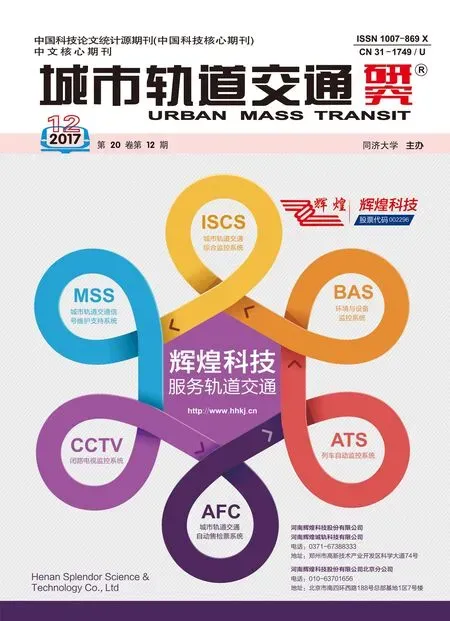城際鐵路與市域鐵路的模糊邊界
孫 章
(同濟大學《城市軌道交通研究》主編,教授)
城際鐵路與市域鐵路的模糊邊界
孫 章
(同濟大學《城市軌道交通研究》主編,教授)

我國的《“十三五”規劃綱要》指出:在城鎮化地區大力發展城際鐵路、市域(郊)鐵路,鼓勵利用既有鐵路開行城際列車,形成多層次軌道交通骨干網絡,高效銜接大中小城市和城鎮。“十三五”期間的城際鐵路、市域鐵路規劃,對推進我國新型城鎮化建設具有重要意義。
在客觀世界中,普遍存在著大量的模糊現象。現代科技所面臨的系統日益復雜,其模糊性也總會伴隨著復雜性出現。城際鐵路與市域鐵路在理論上雖分屬于不同的層次,然而在實踐中,對具體線路定性時常會遇到一個比較復雜的邊界問題。
筆者的少年時代生活在江蘇太倉,可是聽的是上海電臺的廣播,讀的是上海出版的報刊,那時我只知道上海市市長是誰,卻不知道江蘇省省長是誰。長大后才漸漸明白,這就是中心城市的輻射能力所致,與城市群、通勤圈有關,而與行政區劃相對無關。目前從上海市中心到太倉市的公路距離為54 km。筆者設想:假如在這一區間修建一條鐵路,按有關規定,這條線路應該命名為“滬太城際鐵路”;可是它不僅比一般“市域鐵路”短,而且也比某些地鐵線路短。可見,這條線路的名稱就具有模糊性。因此,在這里叫什么名稱并不重要,關鍵取決于采用怎樣的站間距和最高運營速度。這也許就是在國家發展改革委2017年11月24日發布的《鐵路“十三五”發展規劃》中,之所以把城際鐵路和市域(郊)鐵路合并下達2 000 km這一指標的緣由吧。
以上討論的是市域鐵路與城際鐵路的模糊“上邊界”,再看市域鐵路與市區地鐵的模糊“下邊界”:市域鐵路這一新概念源自歐、美、日的都市圈,是鐵路發展先于城市發展的產物。它是都市圈內城市中心區與外圍地區通勤甚至日常出行的交通工具。國外市域鐵路不但能融入城市交通的一體化體系,而且有小部分市域鐵路還能深入城市中心區。其典型的案例就是巴黎的RER線。又如,在11月21日舉行的“2017上海鐵路與城市軌道交通發展創新國際論壇”上,英國倫敦交通局咨詢業務總監Michael Flynn先生告訴聽眾:英國目前正在建設一條東西向穿越倫敦市中心的Crossrail鐵路。這表明他們也要將市域鐵路在城市中心打通,使市域鐵路在城市交通中互聯互通。這是國外市域鐵路一直在努力的方向。這對于乘客而言,市域鐵路與市區地鐵的概念也不十分清晰。有多條市域鐵路的城市還可形成市域鐵路網絡,并生成多個換乘車站。可見,國外對市域鐵路與市區地鐵的區別更注重服務區域的經濟聯系,而非行政歸屬。
城際鐵路、市域鐵路,以及市區的地鐵、輕軌,分別承擔中、短途的通勤、通學、商務及旅游客運。區分軌道交通不同層次的主要技術參數是平均站間距和最高運營速度。這二者之間還必須注意匹配。
在英國倫敦的中心城區內,其市域鐵路的平均站間距為2.5 km,近郊區(半徑為50 km的交通圈內)的平均站間距約3.5 km,遠郊區(半徑為100 km的交通圈內)的平均站間距約7.5 km。平均站間距越大,最高運營速度就越高。日本東京首都圈內的市域鐵路總長達2 013 km,包括JR線887 km和私鐵線路1 126 km。其中,JR線平均站間距為5~6 km,私鐵線路平均站間距為2 km,形態為環線加放射線。東京市域鐵路日均運送旅客2 843萬人次,占其軌道交通總客運量的78%。
目前我國僅北京、上海等少數城市有開通運營的市域鐵路,溫州、南京等城市在建。相比發達國家,雖然在這一方面我國起步較晚,但其發展前景可觀,因而更有必要對一些問題進行研究探討。例如,上海市域鐵路的樣板——金山鐵路,由于管理體制等原因,其運營效果并不十分理想。又如,主要出于條塊分割等管理體制原因,在一些本該建設城際鐵路、市域鐵路的區域卻都建了地鐵。因此筆者建議:在制定相關軌道交通標準的同時,必須加強頂層設計,深化軌道交通的管理體制改革。
(編者注:本文為2017年11月17日作者在南京舉行的“第四屆國際軌道交通紫金論壇”上的演講摘要,本刊發表時作者稍作補充。)
The outline of"The 13th Five-Year Plan"of our country points out:in urbanization areas,intercity railways and city-area railways(suburban railways)should be vigorously developed,using existing railways to run intercity trains should be encouraged,so as to form multi-level rail traffic backbone networks and effectively connect large,medium-sized and small cities and towns.The planning of intercity railways and city-area railways during the period of"The 13th Five-Year Plan"is of great significance to promoting the construction of the new type of urbanization of our country.
In the objective world,there are a lot of widespread fuzzy phenomena.The systems modern science and technology faces are more and more complex,and its fuzziness always comes along with complexity.Although intercity railways and city-area railways belong to different levels in theory,they often encounter a complicated boundary problem when the specific lines are determined the nature in practice.
Although the author in boyhood lived in Taicang,Jiangsu Province,I listened to Shanghai radio stations′broadcast,read the newspapers published in Shanghai.At that time,I only knew who Shanghai′s Mayor was,but did not know who Jiangsu Province′s Governor was.Only after I have grown up can I gradually understand that this is caused by the radiation ability of the central city,is related to urban agglomerations and commuting circles,and is relatively unrelated to administrative divisions.The current highway distance from the center of Shanghai city to Taicang city is 54 km.The author envisages that if a railway is constructed in this area,this railway line should be named"Shanghai-Taicang Intercity Railway"according to the relevant regulations.But it is not only shorter than the general city-area railway,but also shorter than subways.Therefore,what name is called here is not important,and what is important depends on adopting what station spacing and maximum operating speed.This may be the reason why the 2 000 km index of intercity railways′merging with city-area railways was issued in"The Railway Development Plan of the 13th Five-Year Plan"released by the National Development and Reform Commission on November 24,2017.
The above discussion is about the fuzzy"upper boundary"of city-area railways and intercity railways.And then let's look at the fuzzy"lower boundary"of the city-area railways and urban subways.The new concept of city-area railways,which are the product of the railway development's preceding the city development,originates from metropolitan circles of Europe,America and Japan.It is the traffic means of commuting between city center area and the periphery area and even daily traveling inner urban circles.Foreign city-area railways not only can integrate into the urban traffic integration system,but also a small part of the cityarea railways can penetrate the city center.Its typical case is the Paris RER line.For another example,on November 21,2017,at"2017 Shanghai International Forum on Railway and Urban Rail Transit Development Innovation",Mr.Michael Flynn,Director of Consulting Services of London Communications Bureau,told listeners that Britain was building a"Crossrail"railway line running through central London in the east-west direction.This shows that they want to make the city-area railway get through the city center,so that city-area railways can realize interconnection in urban traffic.This is the direction in which the overseas city-area railways have been working hard.For passengers,their concepts of city-area railways and urban metros are also not very clear.Cities with multiple city-area railway lines can also form a city-area railway network and generate multiple railway stations.It can be seen that for the difference between intercity railways and city-area railways,foreign countries pay more attention to the economic relations of the service region than to the administrative attribution.
Intercity railways,city-area railways,and metro and light rails in urban areas respectively undertake business and travel passenger transport of medium-distance or short-distance of commuting for work or school.The main technical parameters that distinguish the different levels of rail transit are the average station spacing and the maximum operating speed.Attention must also be paid to matching between the two.
Inner London's Central District in Britain,the average station spacing of its city-area railways is 2.5 km.In its suburban areas(within the traffic circle of 50 km radius),its average station spacing is about 3.5 km.In its exurban areas(within the traffic circle of 100 km radius),its average station spacing is about 7.5 km.The larger the average station spacing,the higher the maximum operating speed.Their total length of the city-area railways inner Tokyo capital circle in Japan reaches 2 013 km,which,includes 887 km of JR Line and 1 126 km of private rail lines.Among them,JR Line's average station spacing is 5~ 6 km,and the private rail lines′average station spacing is 2 km.The layout form is loop lines plus radiation lines.The Tokyo city-area railways are carrying 28.43 million person-times a day,accounting for 78%of its total rail transit passenger transport volume.
At present,in our country,only a few cities,such as Beijing and Shanghai,have opened city-area railways′operation lines,and some cities,such as Wenzhou and Nanjing,are under city-area railways′constructions.Compared with developed countries,although China's city-area railways started late,they have a broad prospect.Thus,it is still necessary to have some researches and discussions for some problems.For example,Jinshan Railway is a Shanghai city-area railways′model.Because of the management system and other reasons,its operation effect is not very satisfactory.And for another example,mainly because of the reasons of management systems,such as barriers between different departments and regions,and etc.,in those places where intercity railways or city-area railways should be built,subways have been built up.Therefore,the author suggests that we should strengthen the toplevel designs and deepen the reform of the management systems of rail transit while making the relevant rail traffic standards.
(Editor′s note:This article is the abstract of the author′s speech at"The Fourth Zijin Forum of International Rail Traffic"held on November 17,2017 in Nanjing.When it was published by this journal,the author made a slight supplement.)
(Translated by SUN Zheng)
Fuzzy Boundary of Intercity Railways and City-area Railways
SUN Zhang
(Editor-in-Chief of"Urban Mass Transit Research"of Tongji University,Professor)

